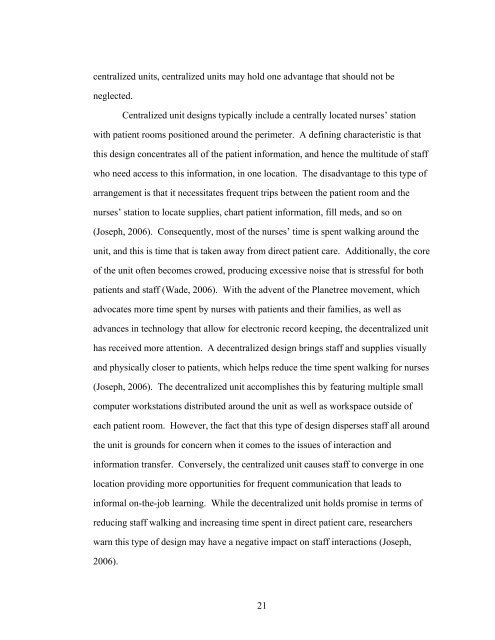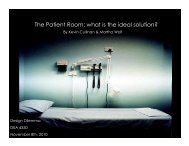The role of physical design and informal communication
The role of physical design and informal communication
The role of physical design and informal communication
Create successful ePaper yourself
Turn your PDF publications into a flip-book with our unique Google optimized e-Paper software.
centralized units, centralized units may hold one advantage that should not be<br />
neglected.<br />
Centralized unit <strong>design</strong>s typically include a centrally located nurses’ station<br />
with patient rooms positioned around the perimeter. A defining characteristic is that<br />
this <strong>design</strong> concentrates all <strong>of</strong> the patient information, <strong>and</strong> hence the multitude <strong>of</strong> staff<br />
who need access to this information, in one location. <strong>The</strong> disadvantage to this type <strong>of</strong><br />
arrangement is that it necessitates frequent trips between the patient room <strong>and</strong> the<br />
nurses’ station to locate supplies, chart patient information, fill meds, <strong>and</strong> so on<br />
(Joseph, 2006). Consequently, most <strong>of</strong> the nurses’ time is spent walking around the<br />
unit, <strong>and</strong> this is time that is taken away from direct patient care. Additionally, the core<br />
<strong>of</strong> the unit <strong>of</strong>ten becomes crowed, producing excessive noise that is stressful for both<br />
patients <strong>and</strong> staff (Wade, 2006). With the advent <strong>of</strong> the Planetree movement, which<br />
advocates more time spent by nurses with patients <strong>and</strong> their families, as well as<br />
advances in technology that allow for electronic record keeping, the decentralized unit<br />
has received more attention. A decentralized <strong>design</strong> brings staff <strong>and</strong> supplies visually<br />
<strong>and</strong> <strong>physical</strong>ly closer to patients, which helps reduce the time spent walking for nurses<br />
(Joseph, 2006). <strong>The</strong> decentralized unit accomplishes this by featuring multiple small<br />
computer workstations distributed around the unit as well as workspace outside <strong>of</strong><br />
each patient room. However, the fact that this type <strong>of</strong> <strong>design</strong> disperses staff all around<br />
the unit is grounds for concern when it comes to the issues <strong>of</strong> interaction <strong>and</strong><br />
information transfer. Conversely, the centralized unit causes staff to converge in one<br />
location providing more opportunities for frequent <strong>communication</strong> that leads to<br />
<strong>informal</strong> on-the-job learning. While the decentralized unit holds promise in terms <strong>of</strong><br />
reducing staff walking <strong>and</strong> increasing time spent in direct patient care, researchers<br />
warn this type <strong>of</strong> <strong>design</strong> may have a negative impact on staff interactions (Joseph,<br />
2006).<br />
21







